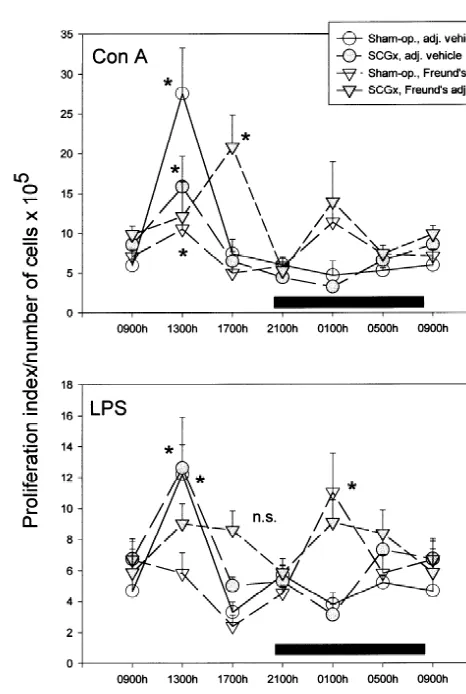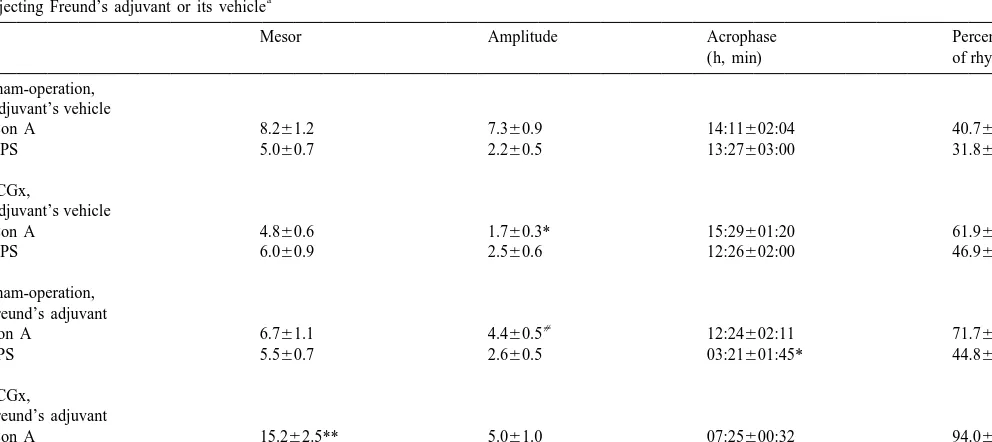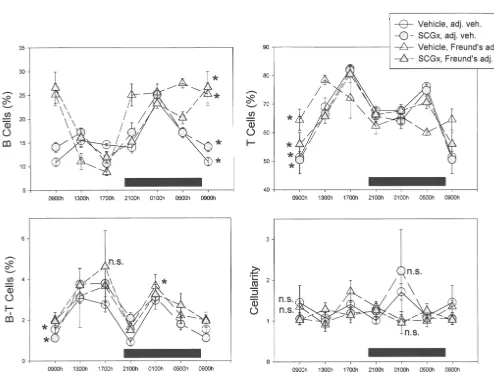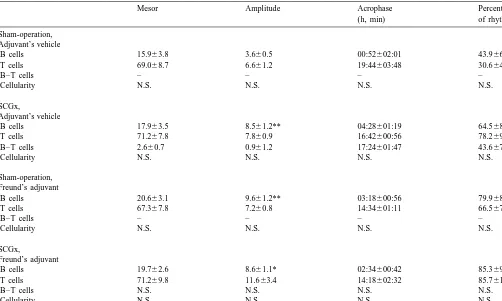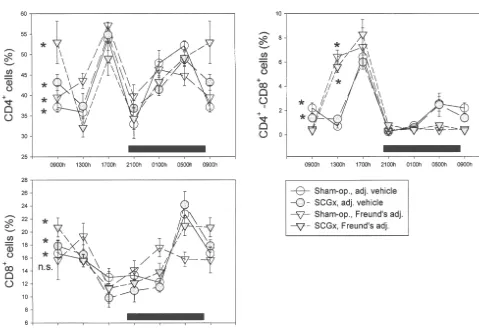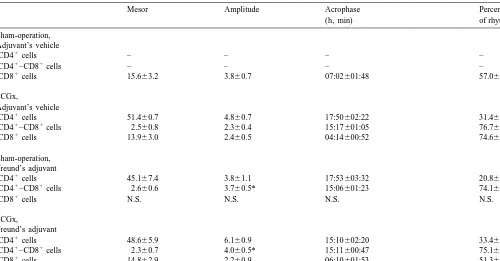www.elsevier.com / locate / bres
Research report
Effect of local sympathectomy on 24-h changes in mitogenic
responses and lymphocyte subset populations in rat submaxillary
lymph nodes during the preclinical phase of Freund’s adjuvant arthritis
a a a b
´
Ana I. Esquifino , Patricia O. Castrillon , Fernando Chacon , Rodolfo Cutrera ,
b ,
*
Daniel P. Cardinali
a´ ´
Departamento de Bioquımica y Biologıa Molecular III, Facultad de Medicina, Universidad Complutense, Madrid, Spain
b
´
Departamento de Fisiologıa, Facultad de Medicina, Universidad de Buenos Aires, Buenos Aires, Argentina
Accepted 3 October 2000
Abstract
Wistar male rats received a bilateral superior cervical ganglionectomy or sham-operation and 10 days later were injected with Freund’s complete adjuvant or its vehicle. Two days later, rats were killed at six different time intervals throughout a 24-h cycle. The mitogenic effect of lipopolysaccharide (LPS) and concanavalin A (Con A) and the relative size of lymphocyte subset populations were measured in submaxillary lymph nodes. Cells from sympathectomized lymph nodes showed a lower response to Con A. Freund’s adjuvant injection decreased amplitude of daily rhythm in Con A response, an effect prevented by denervation. Generally, ganglionectomy increased Con A response at the early phase of arthritis. Acrophases for Con A and LPS effect occurred at early afternoon and did not change after ganglionectomy. Administration of Freund’s adjuvant caused a 10-h advance in acrophase of LPS mitogenic activity, an effect prevented by ganglionectomy. Significant 24-h rhythms were observed in relative size of lymph node B and T cells. Denervation augmented amplitude of rhythm in B cells in adjuvant’s vehicle-injected rats. As far as T lymphocyte subsets, acrophases occurred at the afternoon
1 1 1 1 1 1
(CD4 and CD4 –CD8 cell types) or at night (CD8 cell types). Immunization augmented amplitude of 24-h rhythms in CD4 –CD8
1
cells regardless of innervation whereas denervation counteracted the suppression of daily rhythm in CD8 cells seen in arthritis. The results indicate that some of the changes seen in 24-h organization of immune responses in lymph nodes at an early phase of arthritis are modified by severing the local sympathetic nerves. 2001 Elsevier Science B.V. All rights reserved.
Theme: Endocrine and autonomic regulation
Topic: Neural–immune interactions
Keywords: Superior cervical ganglion; Submaxillary lymph node; Lymphocyte subset; Circadian rhythm; Freund’s adjuvant arthritis
1. Introduction By using this model, it was shown that cytokines like
interleukins 1, 2 or 6, granulocyte-macrophage colony-Injection of Freund’s complete adjuvant to rats leads to stimulating factor or interferon-aare responsible for many an inflammatory disease of the joints that shows four of the symptoms observed as a response to inflammation stages in its time-course: preclinical (first week), acute (e.g. anorexia, depressed activity), also described as ‘sick-(weeks 2–4), postacute ‘sick-(weeks 5–8) and recovery ‘sick-(weeks ness behavior’ [3,21].
9–11) [4]. This inflammatory disease has been widely One feature of mycobacterial adjuvant arthritis less often employed as an experimental model to examine the addressed is the existence of changes in circadian relationships between the brain and the immune system. rhythmicity of biologic responses during the immune reaction. The rationale for circadian organization is the predictive value of the mechanisms enabling an organism
*Corresponding author. Tel.:154-11-4508-3698; fax: 1
54-11-4963-to keep equilibrium in response 54-11-4963-to anticipated variations of
6287.
E-mail address: [email protected] (D.P. Cardinali). the environment [26]. One essential circadian rhythm in
adaptive responses is that of the immune reaction. Circa- daily. Rats had access to food and water ad libitum. dian changes in the circulation of T, B, or natural killer Surgery was performed under tribromoethanol anesthesia (NK) lymphocyte subsets in peripheral blood and in the (250 mg / kg, i.p.). Adequate measures were taken to density of epitope molecules at their surface, which may be minimize pain or discomfort, in accordance with the related to cell reactivity to antigen exposure, have been principles and procedures outlined in European Com-reported (for references see [7]). Changes in lymphocyte munities Council Directives (86 / 609 / EEC).
subset populations depend on time-of-day-associated Rats subjected to a SCGx or its sham-operation 10 days changes in cell proliferation in immunocompetent organs earlier were s.c. injected (at the base of the tail) with and / or on diurnal modifications in lymphocyte release and Freund’s complete adjuvant (0.5 mg heat-killed Mycobac-traffic among lymphoid organs. terium butyricum / rat) or its vehicle (0.5 ml paraffin oil
During recent years we have examined the regulation of containing 15% mannide monooleate) at 1100 h. On the circadian rhythmicity of lymphoid cell proliferation taking second day after Freund’s adjuvant or adjuvant’s vehicle as a model the rat submaxillary lymph nodes. The bilateral injection, groups of 5–7 rats from each experimental group anatomical location of submaxillary lymph nodes and their were killed by decapitation at six different time intervals easily manipulable autonomic innervation allowed us to throughout a 24-h cycle and their submaxillary lymph carry out the analysis of some of the humoral and neural nodes were removed aseptically, weighed and placed in mechanisms regulating the lymphoid organs. Both in Petri disks containing balanced salt solution, the cells immunized and in non-immunized rats a significant diurnal
variation of cell proliferation in submaxillary lymph nodes was reported, displaying maximal activity at early after-noon [5]. Such a maximum coincided with peak mitotic responses to lipopolysaccharide (LPS) and concanavalin A (Con A) in incubated lymph node cells [17]. A purely neural regulatory pathway including as a motor leg the sympathetic and parasympathetic fibers innervating the lymph nodes was identified. In addition, a hormonal pathway involving the circadian secretion of melatonin was also instrumental in producing rhythmicity [6,8].
Studies to be reported herein were addressed to assess further the role of the sympathetic nervous system in the regulation of circadian immune function. We examined the effect of surgical sympathetic denervation of submaxillary lymph nodes, achieved by superior cervical gang-lionectomy (SCGx), on the 24-h changes in the in vitro mitogenic effect of LPS and Con A and in the relative size of lymphocyte subset populations in submaxillary lymph nodes at an early phase of mycobacterial adjuvant arthritis (i.e. on the second day after injection of Freund’s adjuvant or its vehicle).
2. Materials and methods
2.1. Chemicals
3
Thymidine [methyl- H] (specific activity 20 Ci / mmol) was purchased from NEN Research Products (Boston, MA, USA). Freund’s complete adjuvant was purchased
from Difco (Detroit, MI, USA). All other drugs and Fig. 1. Twenty-four hour changes in mitogenic activity of Con A and reagents employed were obtained from Sigma (St. Louis, LPS in submaxillary lymph nodes of rats on the second day after the
MO, USA). injection of Freund’s complete adjuvant or adjuvant’s vehicle. Rats were subjected to SCGx or its sham-operation 10 days earlier. Groups of 4–7 rats were killed by decapitation at six different time intervals throughout a
2.2. Animals and experimental design
24-h cycle. Shown are the means6SEM. Asterisks designate groups in which time-of-day changes were significant, as detected in a one-way
Experiments were carried out in adult male Wistar rats ANOVA (P,0.01); n.s.: not significant time-related changes in a one-way
being gently teased apart. After removing the clumps by studies, we used the following monoclonal antibodies: centrifugation, the cells were suspended in sterile sup- Anti-rat LCA (OX-33) for B lymphocytes (Serotec, Ox-plemented medium (RPMI 1640), containing 10% heat- ford, UK), anti-rat TCR a/b (R7.3) for T lymphocytes inactivated, fetal bovine serum, 20 mM L-glutamine, 0.02 (Serotec), Anti-rat CD4 (OX-35) which recognize a rat T
mM 2-mercaptoethanol and gentamicin (50 mg / ml), and helper cell differentiation antigen (Pharmingen, San Diego, were counted. CA, USA), and anti-rat CD8a (OX-8) which recognize the reactive antigen expressed on rat T cytotoxic / suppressor 2.3. Mitogen assays cells (Pharmingen). Lymphocytes from submaxillary lymph nodes isolated as indicated above, were washed in Mitogen assays were performed as described in detail cold PBS with 0.02% sodium azide and then incubated
5
elsewhere [17]. Submaxillary lymph node cells were (3310 cells / tube) with appropriate primary antibodies for obtained as described above and used at a final number of 30 min at 48C. Following two washes, the cells were
5
cells / well (0.1 ml) of 5310 . Control and experimental incubated with 1 ml of PBS–BSA 1%, for 5 min at 48C, cultures were run in triplicate. Mitogens were added to the washed three times, resuspended in 1% paraformaldehyde cultures at final supramaximal concentrations of 5mg / ml. in PBS. Fluorescence intensity was analyzed by
fluores-plus
The cultures were incubated in a humidified 378C in- cence activated cell sorting (FACStar ; Beckton Dickin-cubator in an atmosphere of 5% CO . After 48 h incuba-2 son, Mountain View, CA, USA). Dead cells were excluded
3
tion, H-thymidine (0.2mCi) was added to each well in a by gating with propidium iodide. volume of 0.02 ml. Cells were harvested 5 h later using a
automated sample harvester, and the filters were counted in 2.5. Statistical analysis a liquid scintillation spectrometer. The proliferation index
was estimated as the ratio between stimulation in the Statistical analysis of results was performed by employ-presence of mitogens / controls. Results were expressed as ing a one-way analysis of variance (ANOVA), followed by proliferation index / number of cells. Student–Newman–Keuls or Dunnett’s t-tests, and a
COSINOR analysis. The latter was used to analyze general
2.4. Lymphocyte subsets rhythmic parameters, i.e. acrophase (the maximum of the sinus function fit by the experimental data), mesor (the The relative size distributions of lymphoid cells in statistical estimate of the mean) and amplitude (half the submaxillary lymph nodes of rats were determined by difference between calculated maximal and minimal val-FACS analysis, as previously described [11,12]. For these ues). P values lower than 0.05 were considered significant.
Table 1
COSINORanalysis of the effect of SCGx on 24-h changes of Con A and LPS mitogenic activity in rat submaxillary lymph nodes, on the second day after
a
Shown are the means6SEM (n54–7 / group). Mesor and amplitude values are expressed as proliferation index / number of cells310 . Asterisks designate
[
significant differences in a one-way ANOVA followed by a Student–Newman–Keuls test, **, P,0.01, *, P,0.05 as compared to the remaining groups, ,
3. Results phase for Con A effect occurred at early afternoon and did not change after denervation (Table 1).
Fig. 1 and Table 1 summarize the effect of sympathetic Acrophase of LPS mitogenic effect was also seen at denervation on 24-h variations in mitogenic effects of Con early afternoon, a picture that did not change after SCGx A and LPS in lymph nodes of rats at the preclinical phase (Fig. 1, lower panel, and Table 1). The administration of of experimental arthritis. Time-of-day-related changes, as Freund’s adjuvant caused a 10-h advance in acrophase of assessed statistically by a one-way ANOVA, were signifi- LPS effect (P,0.05) (Table 1); this effect was prevented cant for all examined groups, except for LPS effect in by SCGx.
SCGx rats treated with Freund’s adjuvant (Fig. 1). Fig. 2 and Table 2 show the effect of SCGx on 24-h SCGx resulted in a lower mitogenic response of lymph rhythms in B, T and B–T cells, and in lymph node node cells to Con A, as shown by a lower peak value in cellularity, of submaxillary lymph nodes of rats at the Fig. 1 (upper panel) and a significantly lower amplitude in preclinical phase of experimental arthritis. Significant
COSINOR analysis (Table 1). Freund’s adjuvant injection time-of-day-dependent changes were observed in every
decreased amplitude of daily rhythm in mitotic response to experimental group for B and T cells, and in all groups Con A, an effect prevented by prior SCGx. Generally, except for SCGx rats treated with Freund’s adjuvant for SCGx increased the Con A response seen in lymph nodes B–T cells. The significant time of day changes in B and T at an early phase of arthritis, as indicated by a significantly cell populations were generally described by a cosine higher mesor value in COSINOR analysis (Table 1). Acro- function, with acrophases occurring at night for B cells and
Table 2
COSINORanalysis of the effect of SCGx on 24-h changes in B, T and B–T cells, and cellularity in rat submaxillary lymph nodes, on the second day after
a
Shown are the means6SEM (n54–7 / group). Mesor and amplitude values are expressed as percent (B, T and B–T cells) or number of cells / mg
5
tissue310 (cellularity). Asterisks designate significant differences in a one-way ANOVA followed by a Dunnett’s t-test, as compared to sham-operated rats injected with adjuvant’s vehicle *, P,0.05, **, P,0.01. N.S., not significant daily changes in a one-way ANOVA; (–): not significant changes in
COSINOR.
during the afternoon for T cells (Table 2). In the case of B of mycobacterial arthritis. This effect was counteracted by cells, a COSINOR analysis indicated a significant increase in SCGx (Fig. 3 and Table 3).
the amplitude of rhythm in adjuvant’s vehicle-injected rats after SCGx (Table 2). A similar increase in B cells was
seen in animals injected with Freund’s adjuvant, an effect 4. Discussion
that occurred regardless of SCGx.
Daily rhythms in T lymphocyte subsets of submaxillary There have been major efforts to understand the in-lymph nodes in rats subjected to SCGx or sham-operation fluence of the nervous system on the immune and in-and injected with Freund’s adjuvant or its vehicle are flammatory responses, e.g. innervation of the immune summarized in Fig. 3 and Table 3. Individual one-way system, molecular communication pathways and complex ANOVA indicated existence of significant time of day phenomena such as conditioning of immune responses and changes for every parameter tested in each experimental mechanisms of host defenses. In turn, the immune system
1
group, except for CD8 cells in sham-operated rats communicates with the neuroendocrine system. Imbalances injected with Freund’s adjuvant. As shown in Table 3, in the neuroendocrine–immune circuitry are relevant, such time-of-day changes could be described in terms of a among other, in host defenses and in injury and repair [3].
1
cosine function, except for daily changes in CD4 and The foregoing results contribute further to the
examina-1 1
CD4 –CD8 cells in sham-operated rats injected with tion of this subject. They indicate that some of the changes adjuvant’s vehicle. Acrophases occurred at the afternoon in the in vitro effect of mitogens and in the size of
1 1 1 1
(CD4 and CD4 –CD8 cells) or at night (CD8 cells). lymphocyte subset populations occurring in submaxillary Immunization augmented significantly the amplitude of lymph nodes at an early phase of mycobacterial adjuvant
1 1
24-h rhythms in CD4 –CD8 cells regardless of the arthritis are modified by the sympathetic denervation of presence of sympathetic nerves (Table 3). A suppression lymph nodes. Uncovered sympathetic denervation effects
1
1 1 1 1
Fig. 3. Twenty-four hour changes in CD4 , CD4 –CD8 and CD8 cell populations in submaxillary lymph nodes of rats on the second day after the injection of Freund’s complete adjuvant or adjuvant’s vehicle. Rats were subjected to SCGx or its sham-operation 10 days earlier. Cell populations were evaluated by FACS. Shown are the means6SEM. Asterisks designate groups in which time of day changes were significant, as detected in a one-way ANOVA (P,0.01); n.s.: not significant time-related changes in a one-way ANOVA. Further analysis employingCOSINORis described in Table 3.
amplitude of daily rhythm in mitotic response to Con A; the acute (after 18 h) and chronic effects of SCGx (after 12 (b) a general increase of Con A response of lymph node days) on in vitro mitogenic responses of lymphocytes from cells; (c) prevention of a 10-h advance in acrophase of LPS submaxillary lymph nodes [10]. At the two time intervals mitogenic activity; (d) prevention of a suppressed daily chosen, essentially different phenomena were taking place
1
rhythm in CD8 cells. In addition, in adjuvant’s vehicle- in the vicinity of sympathetic varicosities, namely, a treated rats, SCGx caused a significant increase in the transient hyperactivity of the denervated organ as a conse-amplitude of B cell rhythm and a lower mitogenic response quence of the supraliminal transmitter release from de-of lymph node cells to Con A. Generally, the results point generating varicosities 18 h after ganglionectomy, and an to a depressive, albeit complex, effect of sympathetic irreversible postsynaptic paralysis after 12 days of opera-innervation on circadian organization of immune response tion. Therefore, an opposite effect of acute and chronic at an early phase of arthritis. SCGx on submaxillary lymph nodes responses to LPS or Experimental arthritis disrupts normal chronobiological Con A could be expected. Such a differential effect of organization since its early developmental phases. This acute and chronic ganglionectomy was apparent in rats was demonstrated elsewhere by showing a significant bearing a situation of increased immunocompetence after effect of immune-mediated inflammatory response on increasing circulating prolactin levels. In these animals, diurnal rhythmicity of ACTH, GH, prolactin and TSH acute SCGx depressed, and chronic ganglionectomy aug-release, which was partially sensitive to immunosuppres- mented, the mitogenic activity of LPS or Con A [10]. sion by cyclosporin [28]. Further experiments indicated These observations were similar to a previously reported that diurnal rhythmicity in hypothalamic levels of hypo- increase of plate-forming cell response in the submaxillary physiotropic hormones was also suppressed at the early lymph nodes of chronically SCGx mice challenged with phase of arthritis. Immunosuppression by cyclosporin did sheep red cells and to the decrease in the plate-forming cell counteract these changes [18]. response found during the anterograde degeneration phase
Indeed, local sympathectomy influences specific re- after SCGx [14].
Table 3
1 1 1 1
COSINORanalysis of the effect of SCGx on 24-h changes in CD4 , CD4 –CD8 and CD8 lymphocyte subpopulations in rat submaxillary lymph nodes,
a
on the second day after injecting Freund’s adjuvant or its vehicle
Mesor Amplitude Acrophase Percent
Shown are the means6SEM (n54–7 / group). Mesor and amplitude values are expressed as percent. Asterisks designate significant differences as compared to the SCGX, adjuvant’s vehicle-injected rats in a one-way ANOVA followed by a Dunnett’s t-test, P,0.05. N.S.: not significant daily changes in a one-way ANOVA; (–): not significant changes inCOSINOR.
[12] A.I. Esquifino, A. Arce, L. Selgas, D.P. Cardinali, Time-dependent
on an early phase of arthritis development presumably deal
effect of cyclosporin on mitogenic responses and lymphocyte subset
with the initial phases of the immune reaction, rather than
populations in rat spleen and submaxillary lymph nodes,
Neuroim-with inflammation. munomodulation 7 (2000) 84–88.
[13] A.I. Esquifino, A. Arce, J.E. Stern, D.P. Cardinali, Effect of stress and cyclosporin on ornithine decarboxylase activity in rat submax-illary lymph nodes, Eur. J. Pharmacol. 285 (1995) 143–149.
Acknowledgements
[14] A.I. Esquifino, D.P. Cardinali, Local regulation of the immune response by the autonomic nervous system,
Neuroimmunomodula-This work was supported by grants from the DGES (PB tion 1 (1994) 265–273.
97-0257), Spain, University of Buenos Aires (TM 07), [15] A.I. Esquifino, D. Pazo, P. Castrillon, P. Cano, A. Arce, D.P.´
´
Consejo Nacional de Investigaciones Cientıficas y Cardinali, Differential effect of interferon-gamma on mitogenic responses in sympathetically-denervated submaxillary lymph nodes
´
Tecnicas, Argentina (PIP 4156) and Agencia Nacional de
of rats, J. Neuroimmunol. 105 (2000) 1–6.
´ ´ ´
Promocion Cientıfica y Tecnologica, Argentina (PICT
[16] A.I. Esquifino, R.E. Rosenstein, J.E. Stern, D.P. Cardinali, Effect of
6153). cyclosporin on ornithine decarboxylase activity in rat submaxillary
lymph nodes: Modulation by sympathetic nerves, Eur. J. Pharmacol. 197 (1991) 161–166.
[17] A.I. Esquifino, L. Selgas, A. Arce, V. Della Maggiore, D.P. Cardinali,
References
Twenty four hour rhythms in immune responses in rat submaxillary lymph nodes and spleen. Effect of cyclosporin, Brain Behav. [1] R.C. Alaniz, S.A. Thomas, M. Perez-Melgosa, K. Mueller, A.G. Immun. 10 (1996) 92–102.
Farr, R.D. Palmiter, C.B. Wilson, Dopamine b-hydroxylase de- [18] A.I. Esquifino, L. Selgas, E. Vara, A. Arce, D.P. Cardinali, Twenty-ficiency impairs cellular immunity, Proc. Natl. Acad. Sci. USA 96 four hour rhythms of hypothalamic corticotropin-releasing hormone, (1999) 2274–2278. thyrotropin-releasing hormone, growth hormone-releasing hormone [2] A.E. Alito, H.E. Romeo, R. Baler, H.E. Chuluyan, M. Braun, D.P. and somatostatin in rats injected with Freund’s adjuvant, Biol.
Cardinali, Autonomic nervous system regulation of murine re- Signals Recept. 8 (1999) 178–190.
sponses as assessed by local surgical sympathetic and parasympa- [19] S. Gonzalez-Ariki, A.J. Husband, The role of sympathetic innerva-thetic denervation, Acta Physiol. Pharmacol. Latinoamer. 37 (1987) tion of the gut in regulating mucosal immune responses, Brain
305–319. Behav. Immun. 12 (1998) 53–63.
[3] H.O. Besedovsky, A. del Rey, Immune–neuro–endocrine interac- [20] S. Gonzalez-Ariki, A.J. Husband, Sympathectomy abrogates im-tions: Facts and hypotheses, Endocrine Rev. 17 (1996) 64–102. munodeficiency associated with protein-energy malnutrition, J. [4] B. Calvino, M.O. Crepon-Bernard, D. Le Bars, Parallel clinical and Neuroimmunol. 99 (1999) 97–104.
behavioural studies of adjuvant-induced arthritis in the rat: possible [21] S. Kent, R.M. Bluthe, K.W. Kelley, R. Dantzer, Sickness behavior as relationship with ‘chronic pain’, Behav. Brain Res. 24 (1987) a new target for drug development, Trends Pharmacol. Sci. 13
11–29. (1992) 24–28.
[5] D. Cardinali, V. Della Maggiore, L. Selgas, A. Esquifino, Diurnal [22] A.P. Kohm, V.M. Sanders, Suppression of antigen-specific Th2 rhythm in ornithine decarboxylase activity and noradrenergic and cell-dependent IgM and IgG1 production following norepinephrine cholinergic markers in rat submaxillary lymph nodes, Brain Res. depletion in vivo, J. Immunol. 162 (1999) 5299–5308.
711 (1996) 153–162. [23] B. Kruszewska, D.L. Felten, S.Y. Stevens, J.A. Moynihan, [6] D.P. Cardinali, L.I. Brusco, M. Garcia Bonacho, A.I. Esquifino, Sympathectomy-induced immune changes are not abrogated by the Effect of melatonin on 24-h rhythms of ornithine decarboxylase glucocorticoid receptor blocker RU-486, Brain Behav. Immun. 12 activity and norepinephrine and acetylcholine synthesis in submax- (1998) 181–200.
illary lymph nodes and spleen of young and aged rats, Neuroen- [24] N.A. Leo, T.A. Callahan, R.H. Bonneau, Peripheral sympathetic docrinology 67 (1998) 349–362. denervation alters both the primary and memory cellular immune [7] D.P. Cardinali, L.I. Brusco, L. Selgas, A.I. Esquifino, Diurnal responses to herpes simplex virus infection,
Neuroimmunomodula-rhythms in ornithine decarboxylase activity and norepinephrine and tion 5 (1998) 22–35.
acetylcholine synthesis in submaxillary lymph nodes and spleen of [25] Y. Liu, E. Ragaa, Z. Li, L. Nuortio, A. Mustafa, M. Bakhiet, young and aged rats during Freund’s adjuvant-induced arthritis, Interferon-gamma and interleukin-12 genes are preferentially ex-Brain Res. 789 (1998) 283–292. pressed during early experimental African trypanosomiasis and [8] D.P. Cardinali, A.I. Esquifino, Neuroimmunoendocrinology of the suppressed by denervation of the spleen, Scand. J. Immunol. 50
cervical autonomic nervous system, Biomed. Rev. 9 (1998) 47–59. (1999) 485–491.
[9] S.L. Carlson, S. Fox, K.M. Abell, Catecholamine modulation of [26] M.C. Moore-Ede, Physiology of the circadian system: Predictive lymphocyte homing to lymphoid tissues, Brain Behav. Immun. 11 versus reactive homeostasis, Am. J. Physiol. 250 (1986) R737–
(1997) 307–320. R752.
´
[10] P. Castrillon, A. Arce, M. Garcia Bonacho, D.P. Cardinali, A.I. [27] C. Pearson, F. Wood, Studies of polyarthritis and other lesions Esquifino, Acute and chronic effects of superior cervical gang- induced in rats by injection of mycobacterial adjuvant. I. General lionectomy on in vitro mitogenic responses of lymphocytes from clinical and pathologic characteristics and some modifying factors, submaxillary lymph nodes of pituitary-grafted rats, Biol. Signals Arthr. Rheum. 2 (1959) 440–459.
Recept. 7 (1998) 25–32. [28] L. Selgas, D. Pazo, A. Arce, A.I. Esquifino, D.P. Cardinali, ´
[11] P. Castrillon, A.I. Esquifino, A. Varas, A. Zapata, R.A. Cutrera, D.P. Circadian rhythms in adenohypophysial hormone levels and hypo-Cardinali, Effect of melatonin treatment on 24-hour variations in thalamic monoamine turnover in mycobacterial-adjuvant-injected responses to mitogens and lymphocyte subset populations in rat rats, Biol. Signals Recept. 7 (1998) 15–24.
